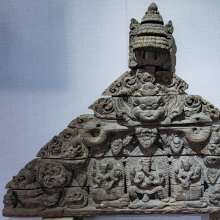Kalpanika, Kālpanika: 11 definitions
Introduction:
Kalpanika means something in Hinduism, Sanskrit, Marathi, Hindi. If you want to know the exact meaning, history, etymology or English translation of this term then check out the descriptions on this page. Add your comment or reference to a book if you want to contribute to this summary article.
Alternative spellings of this word include Kalpnik.
Images (photo gallery)
Languages of India and abroad
Marathi-English dictionary
Source: DDSA: The Molesworth Marathi and English Dictionarykālpanika (काल्पनिक).—a S Invented by the imagination or mind; imaginary, ideal, fictitious: also forged, contrived, devised, thought out.
Source: DDSA: The Aryabhusan school dictionary, Marathi-Englishkālpanika (काल्पनिक).—a Imaginary, contrived, ideal, fictitious.
Marathi is an Indo-European language having over 70 million native speakers people in (predominantly) Maharashtra India. Marathi, like many other Indo-Aryan languages, evolved from early forms of Prakrit, which itself is a subset of Sanskrit, one of the most ancient languages of the world.
Sanskrit dictionary
Source: DDSA: The practical Sanskrit-English dictionaryKālpanika (काल्पनिक).—a. (-kī f.) [कल्पना ठक् (kalpanā ṭhak)]
1) Existing only in fancy, fictitious; काल्पनिकी व्युत्पत्तिः (kālpanikī vyutpattiḥ)
2) Counterfeit, fabricated.
Source: Cologne Digital Sanskrit Dictionaries: Shabda-Sagara Sanskrit-English DictionaryKālpanika (काल्पनिक).—mfn.
(-kaḥ-kī-kaṃ) 1. Artificial, fabricated. 2. Fictitious, invented. E. kalpanā and ṭhak aff.
Source: Cologne Digital Sanskrit Dictionaries: Monier-Williams Sanskrit-English Dictionary1) Kālpanika (काल्पनिक):—[from kālpa] mfn. ([from] kalpanā), existing only in fancy, invented, fictitious, [Sāhitya-darpaṇa; Sarvadarśana-saṃgraha]
2) [v.s. ...] artificial, fabricated.
Source: Cologne Digital Sanskrit Dictionaries: Yates Sanskrit-English DictionaryKālpanika (काल्पनिक):—[(kaḥ-kā-kaṃ) a.] Artificial.
[Sanskrit to German]
Sanskrit, also spelled संस्कृतम् (saṃskṛtam), is an ancient language of India commonly seen as the grandmother of the Indo-European language family (even English!). Closely allied with Prakrit and Pali, Sanskrit is more exhaustive in both grammar and terms and has the most extensive collection of literature in the world, greatly surpassing its sister-languages Greek and Latin.
Hindi dictionary
Source: DDSA: A practical Hindi-English dictionaryKālpanika (काल्पनिक) [Also spelled kalpnik]:—(a) imaginary, fictitious; utopian; hence ~[tā] (nf).
...
Kannada-English dictionary
Source: Alar: Kannada-English corpusKālpanika (ಕಾಲ್ಪನಿಕ):—[adjective] existing only in the imagination; formed or characterised imaginatively; fanciful; unreal; imaginary.
--- OR ---
Kālpanika (ಕಾಲ್ಪನಿಕ):—[noun] a man who can form or has the power of forming, mental images of what is not actually present or experienced; he who is capable of creating or inventing new images, ideas, contrivances, methods, etc. by combining previous experiences; creative man.
Kannada is a Dravidian language (as opposed to the Indo-European language family) mainly spoken in the southwestern region of India.
Nepali dictionary
Source: unoes: Nepali-English DictionaryKālpanika (काल्पनिक):—adj. 1. imaginary; fictitious; 2. artificial;
Nepali is the primary language of the Nepalese people counting almost 20 million native speakers. The country of Nepal is situated in the Himalaya mountain range to the north of India.
See also (Relevant definitions)
Starts with: Kalpanikata, Kalpanikatva.
Ends with: Akalpanika.
Full-text: Kalpanikatva, Kalpanikata, Kalpnik, Karpanikam, Urari.
Relevant text
Search found 6 books and stories containing Kalpanika, Kālpanika; (plurals include: Kalpanikas, Kālpanikas). You can also click to the full overview containing English textual excerpts. Below are direct links for the most relevant articles:
Chaitanya Bhagavata (by Bhumipati Dāsa)
Verse 1.7.175 < [Chapter 7 - Śrī Viśvarūpa Takes Sannyāsa]
A History of Indian Philosophy Volume 2 (by Surendranath Dasgupta)
Part 14 - Ānandabodha Yati < [Chapter XI - The Śaṅkara School of Vedānta (continued)]
Mandukya Upanishad (Gaudapa Karika and Shankara Bhashya) (by Swami Nikhilananda)
Mandukya Upanishad, verse 1 < [Chapter I - Agama Prakarana (Scripture)]
Sisters But Still Strangers < [January – March, 2005]
Reverberations of Dharmakirti’s Philosophy (by Birgit Kellner)
A History of Indian Philosophy Volume 4 (by Surendranath Dasgupta)
Part 1 - Vyāsa-tīrtha, Madhusūdana and Rāmācārya on the Falsity of the World < [Chapter XXIX-XXX - Controversy Between the Dualists and the Monists]
